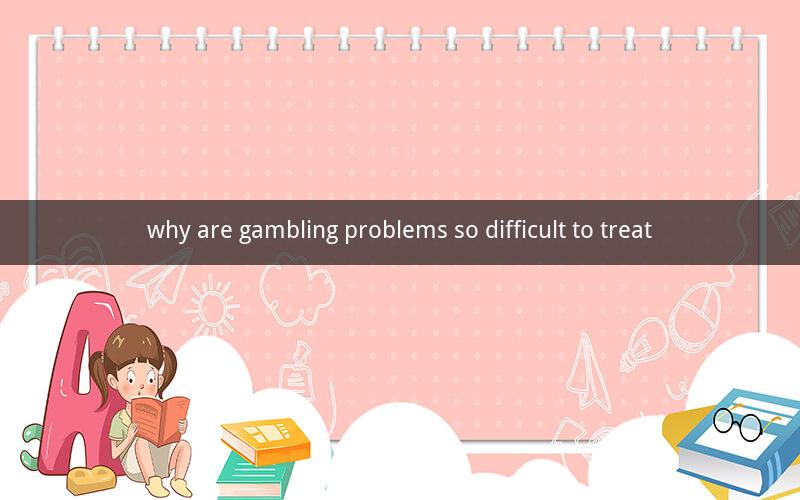
Table of Contents
1. Understanding the Nature of Gambling
2. The Psychological and Social Aspects of Gambling
3. The Role of Dopamine in Gambling
4. The Complexity of Compulsive Gambling
5. Treatment Challenges in Gambling Disorders
6. Therapeutic Approaches to Address Gambling Problems
7. The Importance of Support Networks
8. The Role of Technology in Treatment
9. Long-term Recovery and Relapse Prevention
10. Conclusion
1. Understanding the Nature of Gambling
Gambling, an activity involving risking money or valuable possessions on an uncertain outcome, has been a part of human culture for centuries. While some individuals engage in gambling for leisure, others may develop gambling problems that can disrupt their lives and relationships. The question arises, why are gambling problems so difficult to treat? This article delves into the nature of gambling and the factors that contribute to its challenges in treatment.
2. The Psychological and Social Aspects of Gambling
Gambling problems often stem from a combination of psychological and social factors. Individuals may experience an intense urge to gamble due to psychological triggers such as stress, anxiety, or depression. Social influences, such as exposure to gambling in the media or through peer pressure, can also contribute to the development of gambling problems. Understanding these aspects is crucial in addressing the challenges associated with treating gambling problems.
3. The Role of Dopamine in Gambling
One of the key reasons why gambling problems are difficult to treat is the role of dopamine in the brain. Dopamine is a neurotransmitter associated with pleasure and reward. When individuals gamble, the brain releases dopamine, creating a sense of euphoria and reinforcing the behavior. This reward system can make it challenging for individuals to quit gambling, as they become dependent on the pleasurable sensations associated with the activity.
4. The Complexity of Compulsive Gambling
Compulsive gambling is a complex disorder characterized by an inability to control gambling behavior, despite negative consequences. This complexity arises from various factors, including genetic predisposition, brain chemistry, and environmental influences. Treating compulsive gambling requires a comprehensive approach that addresses these diverse factors.
5. Treatment Challenges in Gambling Disorders
Several challenges make treating gambling disorders difficult. One of the primary challenges is the denial and resistance to seeking help. Individuals with gambling problems may downplay the severity of their addiction or believe they can control their behavior without external support. Additionally, the lack of standardized treatment protocols and limited resources for gambling disorder treatment can further complicate the process.
6. Therapeutic Approaches to Address Gambling Problems
There are various therapeutic approaches available to address gambling problems. Cognitive-behavioral therapy (CBT) is a widely used technique that helps individuals identify and modify maladaptive thoughts and behaviors associated with gambling. Other treatment methods include motivational interviewing, family therapy, and medication. Tailoring treatment to individual needs is essential for successful outcomes.
7. The Importance of Support Networks
Support networks play a vital role in the recovery process for individuals with gambling problems. Friends, family, and support groups provide emotional support, encouragement, and accountability. Building a strong support network can enhance the effectiveness of treatment and reduce the risk of relapse.
8. The Role of Technology in Treatment
Technology has revolutionized the treatment of gambling problems. Online therapy, mobile applications, and virtual support groups provide accessible and convenient resources for individuals seeking help. Additionally, technology can be used to monitor gambling behavior and provide real-time feedback, promoting self-regulation and accountability.
9. Long-term Recovery and Relapse Prevention
Long-term recovery from gambling problems is crucial to maintain sobriety and prevent relapse. Relapse prevention strategies, such as developing healthy coping mechanisms, addressing underlying issues, and maintaining a strong support network, are essential components of long-term recovery. Continuous self-reflection and evaluation of progress are also important in sustaining recovery.
10. Conclusion
Gambling problems are challenging to treat due to the complex interplay of psychological, social, and biological factors. By understanding these factors, employing various therapeutic approaches, and fostering support networks, individuals can overcome their gambling problems and achieve long-term recovery. As research continues to evolve, innovative treatments and interventions will become more available, further enhancing the prospects for individuals struggling with gambling disorders.
Questions and Answers:
1. What is the primary neurotransmitter associated with pleasure and reward in gambling?
Answer: Dopamine
2. What are some psychological triggers that may contribute to gambling problems?
Answer: Stress, anxiety, and depression
3. How can cognitive-behavioral therapy help individuals with gambling problems?
Answer: By identifying and modifying maladaptive thoughts and behaviors
4. What is the role of social influences in the development of gambling problems?
Answer: Exposure to gambling in the media and peer pressure
5. Why are individuals with gambling problems often resistant to seeking help?
Answer: Denial and the belief that they can control their behavior
6. What is the importance of support networks in the recovery process?
Answer: Emotional support, encouragement, and accountability
7. How can technology aid in the treatment of gambling problems?
Answer: Online therapy, mobile applications, and virtual support groups
8. What are some strategies to prevent relapse in gambling disorders?
Answer: Developing healthy coping mechanisms, addressing underlying issues, and maintaining a strong support network
9. Why is long-term recovery crucial in gambling disorders?
Answer: To sustain sobriety and prevent relapse
10. How can individuals achieve long-term recovery from gambling problems?
Answer: By continuously seeking support, engaging in self-reflection, and developing a strong support network